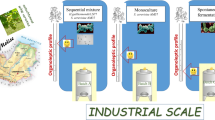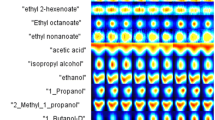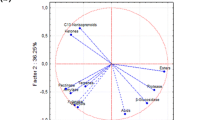Abstract
Decreasing the ethanol content in wine is a current challenge, mainly due to the global climate change and to the consumer preference for wines from grapes with increased maturity. In this study, a central composite design (CCD) and response surface methodology (RSM) approach was used to investigate the potential application of Starmerella bacillaris (synonym Candida zemplinina) in combination with Saccharomyces cerevisiae, in mixed (co-inoculated and sequential) cultures, to understand better the mechanism of co-habitation and achieve the objective of reducing the ethanol in wines. Laboratory scale fermentations demonstrated a decrease up to 0.7 % (v/v) of ethanol and an increase of about 4.2 g/L of glycerol when S. cerevisiae was inoculated with a delay of 48 h with respect to the inoculation of S. bacillaris. Pilot-scale fermentations, carried out in winemaking conditions, confirmed the laboratory results. This study demonstrates that the combination of strains and inoculation protocol could help to reduce the ethanol content in wines.




Similar content being viewed by others
References
Andorrà I, Berradre M, Rozès N, Mas A, Guillamón JM, Esteve-Zarzoso B (2010) Effect of pure and mixed cultures of the main wine yeast species on grape must fermentations. Eur Food Res Technol 231:215–224. doi:10.1007/s00217-010-1272-0
Bely M, Renault P, Da Silva T, Masneuf-Pomerade I, Albertin W, Moine V, Coulon J, Sicard D, De Vienne D, Marullo P (2013) Non-conventional yeasts and alcohol level reduction. In: Teissedre PL (ed) Alcohol level reduction in wine. Vigne et Vin Publications Internationales, Villenave d’Ornon, France, pp. pp 33–pp 37
Bezerra MA, Santelli RE, Oliveira EP, Villar LS, Escaleria LA (2008) Response surface methodology (RSM) as a tool for optimization in analytical chemistry. Talanta 76:965–977. doi:10.1016/j.talanta.2008.05.019
Charpentier C, Colin A, Alais A, Legras JL (2009) French Jura flor yeasts: genotype and technological diversity. Antonie Van Leeuwenhoek 95:263–273. doi:10.1007/s10482-009-9309-8
Contreras A, Hidalgo C, Henschke PA, Chambers PJ, Curtin C, Varela C (2014) Evaluation of non-Saccharomyces yeasts for the reduction of alcohol content in wine. Appl Environ Microbiol 80:1670–1678. doi:10.1128/AEM.03780-13
Contreras A, Curtin C, Varela C (2015a) Yeast population dynamics reveal a potential “collaboration” between Metschnikowia pulcherrima and Saccharomyces uvarum for the production of reduced alcohol wines during Shiraz fermentation. Appl Microbiol Biotechnol 99:1885–1895. doi:10.1007/s00253-014-6193-6
Contreras A, Hidalgo C, Schmidt S, Henschke PA, Curtin C, Varela C (2015b) The application of non-Saccharomyces yeast in fermentations with limited aeration as a strategy for the production of wine with reduced alcohol content. Int J Food Microbiol 205:7–15. doi:10.1016/j.ijfoodmicro.2015.03.027
Duarte FL, Pimentel NH, Teixeira A, Fonseca Á (2012) Saccharomyces bacillaris is not a synonym of C. stellata: reinstatement as Starmerella bacillaris comb. nov. Antonie Van Leeuwenhoek 102:653–658. doi:10.1007/s10482-012-9762-7
Englezos V, Rantsiou K, Torchio F, Rolle L, Gerbi V, Cocolin L (2015) Exploitation of the non-Saccharomyces yeast Starmerella bacillaris (synonym Candida zemplinina) in wine fermentation: physiological and molecular characterizations. Int J Food Microbiol 199:33–40. doi:10.1016/j.ijfoodmicro.2015.01.009
German JB, Walzem RL (2000) The health benefits of the wine. Annu Rev Nutr 20:561–593. doi:10.1146/annurev.nutr.20.1.561
Giaramida P, Ponticello G, Di Maio S, Squadrito M, Genna G, Barone E, Scacco A, Corona O, Amore G, Di Stefano R, Oliva D (2013) Candida zemplinina for production of wines with less alcohol and more glycerol. S Afr J Enol Vitic 34:204–211
Gobbi M, De Vero L, Solieri L, Comitini F, Oro L, Giudici L, Ciani M (2014) Fermentative aptitude of non-Saccharomyces wine yeast for reduction in the ethanol content in wine. Eur Food Res Technol 239:41–48. doi:10.1007/s00217-014-2187-y
Goldner MC, Zamora MC, Di Leo Lira P, Gianninoto H, Bandoni A (2009) Effect of ethanol level in the perception of aroma attributes and the detection of volatile compounds in red wine. J Sens Stud 24:243–257. doi:10.1111/j.1745-459X.2009.00208.x
Gonzalez R, Quirós M, Morales P (2013) Yeast respiration of sugars by non-Saccharomyces yeast species: a promising and barely explored approach to lowering alcohol content of wines. Trends Food Sci Technol 29:55–61. doi:10.1016/j.tifs.2012.06.015
Jones GV, White MA, Cooper OR, Storchmann K (2005) Climate change and global wine quality. Clim Chang 73:319–343. doi:10.1007/s10584-005-4704-2
Magyar I, Tóth T (2011) Comparative evaluation of some oenological properties in wine strains of Candida stellata, Candida zemplinina, Saccharomyces uvarum and Saccharomyces cerevisiae. Food Microbiol 28:94–100. doi:10.1016/j.fm.2010.08.011
Magyar I, Nyitrai-Sárdy D, Leskó A, Pomázi A, Kállay M (2014) Anaerobic organic acid metabolism of Candida zemplinina in comparison with Saccharomyces wine yeasts. Int J Food Microbiol 178:1–6. doi:10.1016/j.ijfoodmicro.2014.03.002
Mangani S, Buscioni G, Collina L, Bocci E, Vincenzini M (2011) Effects of microbial populations on anthocyanin profile of Sangiovese wines produced in Tuscany, Italy. Am J Enol Vitic 62:487–494. doi:10.5344/ajev.2011.11047
Masneuf-Pomarede I, Juquin E, Miot-Sertier C, Renault P, Laizet Y, Salin F, Alexandre H, Capozzi V, Cocolin L, Colonna-Ceccaldi B, Englezos V, Girard P, Gonzalez B, Lucas P, Mas A, Nisiotou A, Sipiczki M, Spano G, Tassou C, Bely M, Albertin W (2015) The yeast Starmerella bacillaris (synonym Candida zemplinina) shows high genetic diversity in winemaking environments. FEMS Yeast Res 15:fov045. doi: 10.1093/femsyr/fov045
Medina K, Boido E, Dellacassa E, Carrau F (2012) Growth of non-Saccharomyces yeasts affects nutrient availability for Saccharomyces cerevisiae during wine fermentation. Int J Food Microbiol 157:245–250. doi:10.1016/j.ijfoodmicro.2012.05.012
Mira de Orduňa R (2010) Climate change associated effects on grape and wine quality and production. Food Res Int 43:1844–1855. doi:10.1016/j.foodres.2010.05.001
Morales P, Rojas V, Quirós M, Gonzalez R (2015) The impact of oxygen on the final alcohol content of wine fermented by a mixed starter culture. Appl Microbiol Biotechnol 99:3993–4003. doi:10.1007/s00253-014-6321-3
Nissen P, Nielsen D, Arneborg N (2003) Viable Saccharomyces cerevisiae cells at high concentrations cause early growth arrest of non-Saccharomyces yeasts in mixed cultures by a cell-cell contact-mediated mechanism. Yeast 20:331–341. doi:10.1002/yea.965
Pérez-Nevado F, Albergaria H, Hogg T, Girio F (2006) Cellular death of two non-Saccharomyces wine-related yeasts during mixed fermentation with Saccharomyces cerevisiae. Int J Food Microbiol 108:336–345. doi:10.1016/j.ijfoodmicro.2005.12.012
Pickering GJ (2000) Low-and reduced-alcohol wine: a review. J Wine Res 11:129–144. doi:10.1080/09571260020001575
Quirós M, Rojas V, Gonzalez R, Morales P (2014) Selection of non-Saccharomyces yeast strains for reducing alcohol levels in wine by sugar respiration. Int J Food Microbiol 181:85–91. doi:10.1016/j.ijfoodmicro.2014.04.024
Rantsiou K, Dolci P, Giacosa S, Torchio F, Tofalo R, Torriani S, Suzzi G, Rolle L, Cocolin L (2012) Candida zemplinina can reduce acetic acid production by Saccharomyces cerevisiae in sweet wine fermentations. Appl Environ Microbiol 78:1987–1994. doi:10.1128/AEM.06768-11
Ribéreau Gayon P, Dubourdieu D, Donèche B, Lonvaud A (2006) The microbiology of wine and vinifications. Handbook of enology, vol. 1, 2nd edn. Wiley, Chichester, England
Rolle L, Giordano M, Giacosa S, Vincenzi S, Río Segade S, Torchio F, Perrone B, Gerbi V (2012) CIEL*a*b* parameters of white dehydrated grapes as quality markers according to chemical composition, volatile profile and mechanical properties. Anal Chim Acta 732:105–112. doi:10.1016/j.aca.2011.11.043
Room R, Babor T, Rehm J (2005) Alcohol and public health. Lancet 365:519–530. doi:10.1016/S0140-6736(05)17870-2
Sadoudi M, Tourdot-Maréchal R, Rousseaux S, Steyer D, Gallardo-Chacón J, Ballester J, Vichi S, Guérin-Schneider R, Caixach J, Alexandre H (2012) Yeast-yeast interactions revealed by aromatic profile analysis of Sauvignon Blanc wine fermented by single or co-culture of non-Saccharomyces and Saccharomyces yeasts. Food Microbiol 32:243–253. doi:10.1016/j.fm.2012.06.006
Saliba AJ, Ovington LA, Moren CC (2013) Consumer demand for low-alcohol wine in an Australian sample. Int J Wine Res 5:1–8. doi:10.2147/IJWR.S41448
Soden A, Francis IL, Oakey H, Henschke PA (2000) Effects of co-fermentation with Candida stellata and Saccharomyces cerevisiae on the aroma and composition of Chardonnay wine. Wine Aust J Grape Wine Res 6:21–30. doi:10.1111/j.1755-0238.2000.tb00158.x
Suzzi G, Schirone M, Sergi M, Marianella RM, Fasoli G, Aguzzi I, Tofalo R (2012) Multistarter from organic viticulture for red wine Montepulciano d’Abruzzo production. Front Microbiol 3:1–10. doi:10.3389/fmicb.2012.00135
Torchio F, Rio Segade S, Gerbi V, Cagnasso E, Rolle L (2011) Changes in chromatic characteristics and phenolic composition during winemaking and shelf-life of two types of red sweet sparkling wines. Food Res Int 44:729–738. doi:10.1016/j.foodres.2011.01.024
Tristezza M, Vetrano C, Bleve G, Spano G, Capozzi V, Logrieco A, Mita G, Grieco F (2013) Biodiversity and safety aspects of yeast strains characterized from vineyards and spontaneous fermentations in the Apulia region, Italy. Food Microbiol 36:335–342. doi:10.1016/j.fm.2013.07.001
Van Dijken JP, Scheffers WA (1986) Redox balances in the metabolism of sugars by yeasts. FEMS Microbiol Lett 32:199–224. doi:10.1111/j.1574-6968.1986.tb01194.x
Yoo YJ, Saliba AJ, Prenzler PD (2010) Should red wine be considered a functional food? Comp Rev Food Sci Food Saf 5:530–551. doi:10.1111/j.1541-4337.2010.00125.x
Acknowledgments
This work was funded by the (FP7/2007-2013) under grant agreement no. 315065–WILDWINE (www.wildwine.eu). The information in this document reflects only the author’s views, and the Community is not liable for any use that may be made of the information contained herein.
Author information
Authors and Affiliations
Corresponding author
Ethics declarations
This paper does not contain any studies with human participants or animals.
Conflict of interest
The authors declare that there is no conflict of interest.
Electronic supplementary material
ESM 1
(PDF 918 kb)
Rights and permissions
About this article
Cite this article
Englezos, V., Rantsiou, K., Cravero, F. et al. Starmerella bacillaris and Saccharomyces cerevisiae mixed fermentations to reduce ethanol content in wine. Appl Microbiol Biotechnol 100, 5515–5526 (2016). https://doi.org/10.1007/s00253-016-7413-z
Received:
Revised:
Accepted:
Published:
Issue Date:
DOI: https://doi.org/10.1007/s00253-016-7413-z




